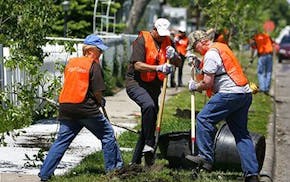Cassie Potter, 30, St. Paul, Olympic curler
As a child, Cassie Potter loved to hang out at the curling club in her hometown of Bemidji, Minn. Not surprisingly, Potter -- the daughter, granddaughter and great-granddaughter of curlers -- picked up the sport at a young age and went on to represent the United States at the 2006 Olympics, along with her sister, Jamie Haskell. Their team has already been selected to compete in the next Olympic trials. Potter recently explained how curling contributes to her fitness as she prepared for her role as an alternate on the U.S. team that's competing from Saturday to March 25 at the 2012 World Women's Curling Championship in Lethbridge, Alberta.
A FAMILY AFFAIR "The Bemidji Curling Club was our place to just hang out and goof off and have fun. My sister and I would go to watch our parents curl. When we got old enough -- 6 or 7 -- we started out with lighter-weight rocks so we could actually move them around. It was really cool to be able to do what our parents and the older grownups did. Our family has done it for so long that it's just kind of ingrained in who we are. And my parents knew so many other people who curled, and their kids grew up to be curlers -- so it turned into one big extended family."
FROM PASTIME TO PASSION "It started out being just something fun to do growing up in northern Minnesota, where there's not a whole lot to do in the winter months. But then you get to meet new people and make friends, and once you start traveling you become a community of people who share this common, interesting sport. My sister and I started curling competitively in 1996, about 10 years after we'd been playing for fun."
ENERGY AND BALANCE "My sister and I tried various other sports; besides curling, we stuck with tennis. [Like curling], it requires a lot of short bursts of energy. [In curling] you also need to have excellent balance, and to be able to fully exert yourself, for sweeping, for 30 seconds. You need to work really vigorously and come back to a controlled heart rate. You need the ability to rebound back to resting rates and calm down -- and focus -- to deliver your stones without falling over. Off-ice, it's about staying physically fit, doing your own workout routine, like running and lifting. On ice, I'm in league once a week and I get to practice a couple of times during the week if I can get on -- it's tough in St. Paul to get ice."
STRATEGIC MOVES "Agility and flexibility and upper-arm and shoulder strength also help for sweeping. And a lot of curling is not about pushing the rock, but creating momentum from your leg drive from a crouching position to a lunge. And there's a lot of little things. You have to be mentally tough in the high levels, like in the Olympics. You've got to be able to take the losses with the wins and be able to bounce back. And there's so much strategy with the sport of curling that you don't really understand until you get into it."
TORINO 2006 "In 2005, my sister and I won the U.S. women's nationals, which happened to be the U.S. Olympic trials. We got to go to the Olympics in 2006. It was incredible, especially the opening ceremonies. It was this feeling of being part of a large team."
COMPETITOR OR TEAMMATE? "When you get to the top level, you pretty much know everybody there. It's a very small community. And the teams intermix, so you play against each other one year and then with each other the next year. It's kind of just a big family."
JUST DOING IT "Canada is usually the team to beat -- they have many more curlers and fans and support, sponsorships and television coverage. In the U.S., it's more of an obscure sport, but it's been doing much better in the past two years with Nike as an apparel sponsor. It's fun to be able to watch curling grow and be part of that era. I can't ever see a time where curling wouldn't be a part of my life -- it's so much a part of who I am."

Yuen: Why do people forgive? It's messy, complex and 'the best form of self-interest'
How the Goo Goo Dolls learned the music biz from Minneapolis bands
